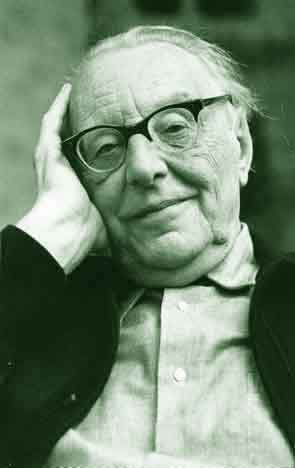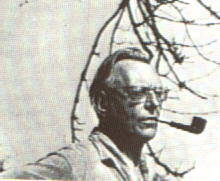Musik für
Kinder

''Since the beginning
of time, children have not liked to study. They would much rather
play, and if you have their interests at heart, you will let
them learn while they play; they will find that what they have
mastered is child's play.''

The sparkling, gamelan-like
chimes heard on the Langley recordings emanate from Orff percussion
instruments. These simple mallet-struck melody-makers were invented
by German composer and educational theorist Carl Orff (1895-1982)
as elemental teaching tools. Orff believed that any child --
regardless of talent, cultural milieu, or physical constraint
-- could partake of the joys of playing music with little or
no traditional training.
Perhaps best
known as the composer of the scenic oratorio, Carmina Burana
(1937), Orff had long been a proponent of alternative music instruction.
He felt that the primal behaviors of children -- for instance,
clapping, chanting, banging out a beat, and dancing -- were better
educational building blocks than technical studies. He believed
that once children learned to appreciate fundamental music-making
through rhythmic activities and games, they could be taught to
read and write notation.
Orff and his associate Dorothee Günther founded, in 1924,
the Munich-based Güntherschule, where music, dance,
and gymnastics were taught. Gunild Keetman, who enrolled as a
student in 1926, eventually became Orff's partner in the evolution
of the Orff Schulwerk -- literally, "school work,"
but more specifically a focus on creative, educational activity
through speech, music and movement. The Schulwerk also
promotes cooperation and teamwork -- students are encouraged
to listen to each other, to hear what their neighbor is playing,
and to be conscious of the ensemble sound.
An outgrowth
of the Schulwerk was the development of an instrumentarium
on which students could express themselves rhythmically and melodically.
Orff drew on the delicate, enchanting Indonesian gamelan orchestra
and early African percussion for his diatonic and chromatic xylophones,
glockenspiels, and metallophones. These are augmented by an arsenal
of bells, hand drums, claves, resonator bars, jingle rings, temple
blocks, shakers and other rhythmic noisemakers. The simple-to-play
Orff instruments were designed to make the music-learning experience
fun and exploratory, while helping develop motor skills. Children
are taught to concentrate on repeated pulses and melodic patterns
(ostinato), and improvisation is encouraged.
Between 1950
and 1954, Orff and Keetman completed and published the five-volume
Music For Children, which codified their methodology,
and which subsequently sparked international advocacy. Today,
Orff organizations are based in the U.S. (85 chapters in all
50 states), Canada, most western and many eastern European nations
(including Russia and Poland), Australia, New Zealand, Japan,
Taiwan, the People's Republic of China, and South Africa. According
to the American Orff-Schulwerk Association, an estimated 11,000
U.S. teachers, to varying degrees, introduce youngsters to the
wonders of music using Orff techniques.
Orff melody
instruments heard on the Langley sessions include wooden xylophones
and metallophones (whose metal bars sustain resonance longer
than wood). A unique characteristic of this pitch percussion
is that bars can be removed from the tonal array, thereby guiding
children to hit the right notes. Consequently, as Hans Fenger
observed, "even a little kid can jam." In addition,
the Orff technique of "body music" is reflected in
the clapping and foot-stomping heard on "Saturday Night,"
"Rock Show," and "I'm Into Something Good."
What makes
the Langley project so unusual is that Orff techniques are not
generally performance-oriented; they are learning-focused.
Rather than being used to play "songs," the tuned percussion
often provides a "sound carpet" for vocalizing and
expressive movement. Even rarer is the use of the instrumentarium
to render contemporary pop; the Schulwerk instead encourages
the performance of indigenous folk music. There is a limited
repertoire of original compositions written specifically for
the instruments, such as Libby Larsen's "Song-Dances to
the Light" (whose score also includes conventional orchestral
instruments and chorus). Larsen also notes, "Philip Rhodes,
a very fine composer who taught for a number of years at Carleton
College in Northfield, Minnesota, has composed some very fine
work for Orff instrumentarium." Upper grades occasionally
use Orff percussion to improvise on the blues or jazz. But to
play songs by the Beach Boys, David Bowie, Fleetwood Mac and
the Bay City Rollers? To perform "Calling Occupants of Interplanetary
Craft"? Pretty much unheard of. Fenger did this in the mid-1970s,
but had to wait a quarter-century for a wider hearing.
In the Schulwerk,
Orff refrained from grand didactic strictures; he provided simple
formulas that would inspire teachers to exercise their own imaginations
in the classroom. Thus, Orff educational activities become learning
experiences for teachers as well as pupils. Certainly Fenger
-- who had some Orff training -- took these liberties to heart
in his selection of songs and his adventurous arrangements. As
he said, with a preceding demurral of modesty, "Every note
came out of my head."
Hermann Regener
wrote of the "timeless quality" of the Schulwerk,
adding that it "does not prepare one only for an understanding
of the classics or of medieval or contemporary music. [It] foster[s]
fundamental, general benefits of value to the whole person."
In the case of the Langley students, it is abundantly evident
that they performed these songs with body and soul.

For further information:
The
American Orff-Schulwerk Association (AOSA)
P.O. Box 391089, Cleveland, Ohio 44139-8089
(440) 543-5366
www.aosa.org
Carl
Orff Canada - Musique pour enfants
www.orffcanada.ca
Orff
Schulwerk Around the World:
check www.aosa.org web site for links



